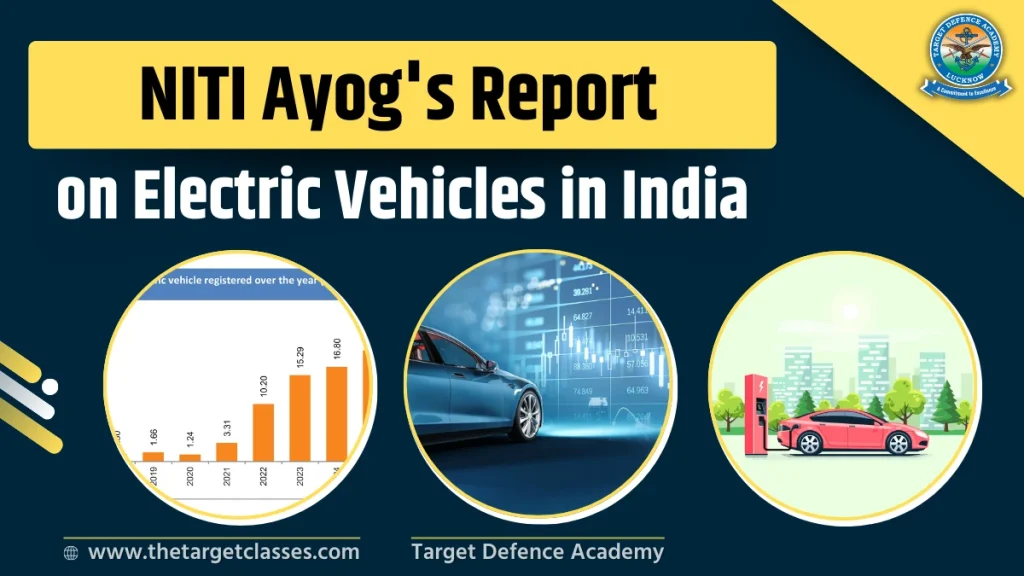Context
NITI Aayog launched the Report on ‘Unlocking a $200 Billion Opportunity: Electric Vehicles in India. This report provides a time-bound and comprehensive review of current issues, along with actionable recommendations to accelerate the EV transition in India.
Major Highlights
(i) The key objectives of India’s EV Push:
(a) Reduced dependence on imported fuel.
(b) Increased share of renewable energy by leveraging the storage capacity of EV batteries.
(c) Reduced Greenhouse Gases (GHG) emissions.
(d) Improved air quality.
(e) Improved Plant Load Factor (PLF) of electricity-generating plants.
(f) Becoming a leader in a rapidly growing global market.
(ii) Goal: India seeks to attain a 30% share of electric vehicles in the total vehicles sold by 2030.
(iii) Adoption of EVs: Sales of EVs in India went up from 50,000 in 2016 to 2.08 million in 2024. The adoption of EVs has been increasing in India, but the adoption rate is slower than in countries like the United States and the European Union.
(iv) India’s Progress: India has progressed to only about 7.6 % of its sales in 2024 being electric, which is far behind its target of 30% by 2030. Thus, it has taken nearly 10 years to reach a penetration level of 7.6% and now needs to increase this share by over 22% in the next 5 years alone.

Challenges
(i) There are challenges of financing vehicles, especially electric buses, as well as electric trucks.
(ii) Inadequacy of charging facilities on one hand and low utilisation of existing public charging facilities on the other hand.
(iii) Inawareness about electric vehicles among the stakeholders.
(iv) Lack of data and regulatory issues consequently hamper evidence-based decision-making.
Steps to promote EV Adoption in India
(i) Moving from incentives to Mandates: Announce a clear policy, with target timelines, for Zero Emission Vehicle (ZEV) adoption. Design a progressively more stringent plan for mandating the production and purchase of EVs and disincentivising the continued use/production of ICE vehicles.
(ii) Saturation instead of thin distribution: Design and start a saturation program to support 5 cities over 5 years. Have entities in the States to manage this program. Scale up to 20 cities and then to 100 cities.
(iii) Enable financing for e-Buses and e-Trucks: Create a pooled fund with contributions from the public budget and multilateral institutions. Design and launch an appropriate scheme to channel the funds.
(iv) Scale up research for new battery technologies: Set up an academia-industry-government partnership for accelerating research on new battery chemistries.
(v) Strategic scaling of charging infrastructure: Identify 20 high-density corridors for e-Bus and e-Truck operations and commission a study to identify strategic locations for charging hubs based on current voltage patterns on these corridors. Make nodal agencies in each state to ensure more charging stations open there.
- Electric Mobility of India: Key Components & Challenges
- Unveiling India’s Energy Transition: Target Achieving 500 GW of Renewable Energy
- Ethanol Blending: A Step Towards Cleaner Energy
- Download the Mobile App of Target Defence Academy
Conclusion
India’s EV journey, supported by state-of-the-art policies, tech upgradation, and rising consumer awareness, is set to transform the landscape of the sector. Incessant focus on infra development, indigenous battery manufacturing, as well as strong policy support, will ensure the fulfilment of India’s EV targets. This transition will foster sustainable growth, enhance energy security, as well as contribute significantly to global climate goals.

